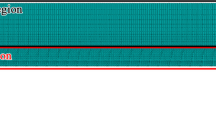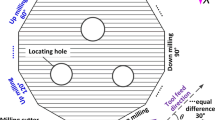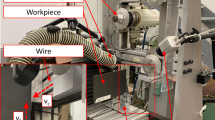Abstract
This study investigates the effect of rake angle on cutting performance during machining of stone-plastic composite material with diamond cutters. To that end, an orthogonal cutting experiment was designed, in which stone-plastic composite material was planed by a polycrystalline diamond (PCD) cutter to produce chips. The features studied include cutting forces, cutting heat, chip formation and cutting quality. The conclusions are as follows: Firstly, increased rake angle causes frictional force and resulting force to decrease, promoting an increase in normal force. Secondly, during planing, cutting heat is primarily distributed in the chips, with less retained in the cutting edge, and the least retained in the machined surface. The temperatures of both cutting edge and chip decline with an increase in rake angle. Thirdly, as rake angle increases, chip morphology changes from segmental to curved and then to particle chips, with chip-breaking lengths first increasing and then decreasing. Finally, an increased rake angle leads a more stable cutting process and improved cutting quality. Therefore, with the precondition of blade strength, a diamond cutter with a larger rake angle can be used to machine stone-plastic composite to improve production quality by forming a smoother machined surface.
Similar content being viewed by others
References
Z. Hutyrovã, M. Harnicarova, J. Zajac, J. Valicek and J. Mihok, Experimental study of surface roughness of wood plastic composites after turning, Adv Mater Res, 856 (2014) 108–112, https://doi.org/10.4028/www.scientific.net/AMR.856.108.
Y. X. Liu, Stone and plastic floor, C.N. Patent 201,232,335Y, May 6 (2009) https://patents.google.com/patent/CN2012 32335Y/en.
S. Turchetta, Cutting force and diamond tool wear in stone machining, Int. J. Adv. Manuf. Tech., 61 (2012) 441–448, https://doi.org/10.1007/s00170-011-3717-4.
H. S. Kim and Y. W. Mai, Effect of temperature on fatigue crack growth in unplasticized polyvinyl chloride, J. Mater. Sci., 28 (1993) 5479–5485, https://doi.org/10.1007/BF00367818.
Z. L. Zhu, X. L. Guo, M. Ekevad, P. X. Cao, B. Na and N. F. Zhu, The effects of cutting parameters and tool geometry on cutting forces and tool wear in milling high-density fiberboard with ceramic cutting tools, Int. J. Adv. Manuf. Tech., 91 (2017) 4033–4041, https://doi.org/10.1007/s00170-017-0085-8.
X. L. Guo, Z. L. Zhu, M. Ekevad, X. Bao and P. X. Cao, The cutting performance of Al2O3 and Si3N4 ceramic cutting tools in the milling plywood, Adv. Appl. Ceram., 117 (2017) 16–22, https://doi.org/10.1080/17436753.2017.1368946.
Z. L. Zhu, X. L. Guo, B. Na, X. Y. Liang, M. Ekevad and F. Ji, Research on cutting performance of ceramic cutting tools in milling high density fiberboard, Wood Res-Slovakia, 62 (2017) 125–138, https://doi.org/www.diva-portal.org/smash/record.jsf?pid=diva2%3A1086171&dswid=9158.
J. Konstanty, Production parameters and materials selection of powder metallurgy diamond tools, Powder Metall, 49 (2013) 299–306, https://doi.org/10.1179/174329006X113508.
J. D. Dwan, Production of diamond impregnated cutting tools, Powder Metall, 41 (2013) 84–86, https://doi.org/10.1179/pom.1998.41.2.84.
R. R. Li, P. X. Cao, S. B. Zhang, W. Xu, M. Ekevad and X. L. Guo, Predicting of cutting force during gypsum fiber composite milling process using response surface methodology, Wood Fiber Sci., 49 (2017) 453–460, https://doi.org/www.divaportal.org/smash/record.jsf?pid=diva2%3A1150151&dswid=-6025.
H. X. Wang, W. J. Zong, D. Li and S. Dong, Feed rate and depth of cut influence on cutting forces in diamond turning aluminium alloy, Mate. Sci. Forum., 471 (2004) 634–639, https://doi.org/scholar.google.com.hk/scholar?cluster=7810961872103927919&hl=zh-CN&as_sdt=0,5.
D. Xu, J. Zhang, Z, Wang, H. Zhang and Q. Sun, Study on sawing forces of diamond frame saw in granite cutting, Dia. Abr. Eng., 35 (2015) 21–25, https://doi.org/10.13394/j.cnki.jgszz.2015.2.0004.
Y. J. Zhang, G. J. Dong and M. Zhou, The study of the influence of tool wear on cutting temperature in diamond ultra-precision cutting of aluminum alloy mirror, Key Eng. Mate., 693 (2016) 982–989, https://doi.org/10.4028/www.scientific.net/KEM.693.982.
M. Sato, K. Miyazaki and H. Tanaka, Radiational thermometry of diamond tool tip temperature in micro cutting, J. Jan. Soc. Precis. Eng., 74 (2008) 51–56, https://doi.org/10.2493/jjspe.74.51.
Z. C. Niu, F. F. Jiao and K. Cheng, An innovative investigation on chip formation mechanisms in micro-milling using natural diamond and tungsten carbide tools, J Manuf Process, 31 (2018) 382–394, https://doi.org/10.1016/j.jmapro.2017.11.023.
J. Q. Lin, L. Guan, M, M. Lu, J. G. Han and Y. D. Kan, Modeling and analysis of the chip formation and transient cutting force during elliptical vibration cutting process, Aip Adv., 7 (2017) 125101, https://doi.org/10.1063/1.5006303.
N. Chen, M. J. Chen, Y. Q. Guo and X. B. Wang, Effect of Cutting parameters on surface quality in ductile cutting of KDP crystal using self-developed micro PCD ball end mill, Int. J. Adv. Manuf. Tech., 78 (2015) 221–229, https://doi.org/10.1007/s00170-014-6623-8.
H. Hocheng and M. L. Hsieh, Signal analysis of surface roughness in diamond turning of lens molds, Int. J. Mach. Tool. Manu., 44 (2004) 1607–1618, https://doi.org/10.1016/j.ijmachtools.2004.06.003.
W. H. Wu, W. M. Chen, X. H. Wang and C. Zhao, Influence of cutting parameters and tool geometric angles on TC4 titanium alloy chip shape, Adv. Mater. Res., 490 (2012) 3912–3915, https://doi.org/10.4028/www.scientific.net/AMR.490-495.3912.
J. P. Costes, P. L. Ko, T. Ji, C. Decespetit and Y. Altintas, Orthogonal cutting mechanics of maple: modeling a solid wood-cutting process, J. Wood Sci., 50 (2004) 28–34, https://doi.org/10.1007/s10086-003-0527-9.
Author information
Authors and Affiliations
Corresponding author
Additional information
Recommended by Associate Editor Yongho Jeon
Pingxiang Cao is a Professor of College of Materials Science and Engineering, Nanjing Forestry University, China. His research interests are concerned with wood machining, cutting tools, wood-based composite materials.
Rights and permissions
About this article
Cite this article
Cao, P., Zhu, Z., Buck, D. et al. Effect of rake angle on cutting performance during machining of stone-plastic composite material with polycrystalline diamond cutters. J Mech Sci Technol 33, 351–356 (2019). https://doi.org/10.1007/s12206-018-1237-y
Received:
Revised:
Accepted:
Published:
Issue Date:
DOI: https://doi.org/10.1007/s12206-018-1237-y




